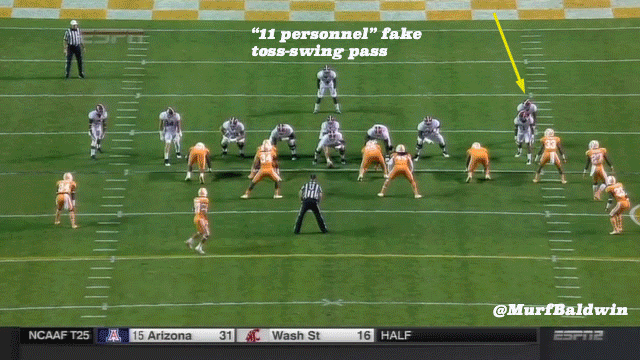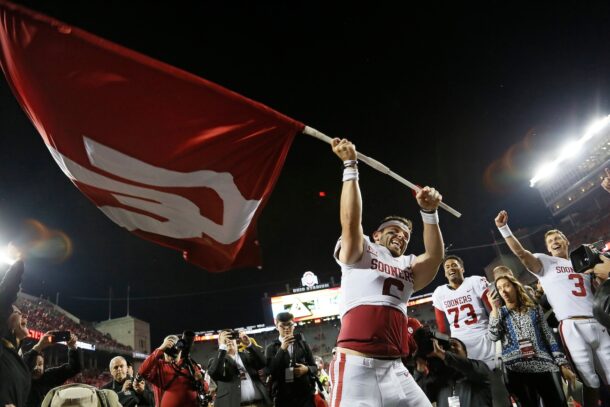Film Study: Bama WR Cooper a better player than even Julio Jones
By Murf Baldwin
Published:
Although it may be pretty much sacrilegious to say (in a football sense) — considering former Alabama Crimson Tide superstar receiver Julio Jones is partly responsible for the program’s on-going success — I wholeheartedly believe that current star receiver Amari Cooper is the best in Alabama’s history.
And while it’s no slight to Jones, who could be considered the best receiver in the NFL not named Calvin Johnson, I can’t come up with any legitimate aspect in receiving that he’s better at over Cooper.
Furthermore, the 6’3″, 220-pound Jones, who is an athletic freak among athletic freaks, shouldn’t even be considered a better athlete than Cooper, either (if anything, it’s a wash).
Fans at the Capstone should cherish the last bit of games of Cooper’s college career, because chances are we won’t see another receiver like him for a long time.
This kid is that darn good.
Background
For those of you who have followed my career, you know that I’m extremely honest and consistent. When I previously did a piece on Cooper having the tools to be the best receiver of head coach Nick Saban’s tenure, I did so under the pretense that he needed to have a sensational junior season.
While his freshman season was the best in school history, his injury-plagued sophomore season left a little bit to be desired — although it wasn’t as futile as most made it out to be.
And while I’m not making this bold proclamation solely on the basis of stats — because I pride myself in being versed in the intricacies of the sport — it doesn’t hurt that Cooper is in line to own all of Alabama’s receiving records in record time.
But I’ve seen all I need to see from Cooper; he could shut it down today and my mind couldn’t be swayed.
Make no mistake about it; I completely understand the significance of Jones. Not only is he going to go down as one of the greatest receivers the sport has ever seen, he will also go down as a great ambassador for the game and, most importantly, a key cog to the resurgence of Bama’s dynasty.
Jones, along with Mark Ingram, Trent Richardson, and Andre Smith made it cool for highly touted high school prospects to go to Alabama once again.
Coming on the heels of the forgettable Mike Shula era (or error), the presence of those athletes (in addition to Saban, of course) erased the sour taste some may have had toward the historic program.
As it pertains to Jones, the hype surrounding around his arrival was only superseded by his on-field play. His ability to win in the short-to-intermediate game was unmatched, and his athleticism was highly evident in his ability to stretch the field.
His billing as a generational-type player was right on the money. But it goes to show you how fast time flies because Cooper possesses all those characteristics and then some.
Debatables
As I’ve lobbied this theory to many of my fellow writers, readers and naysayers, most of them all say the same thing: Jones is by far the best. While that statement is ludicrous in itself, the reasoning behind it is even worse.
Most can’t come up with a concrete example to support Jones, so they say generic stuff like “Jones is bigger.” While that is undoubtedly true, as Cooper is listed at 6’1″, 210 pounds, what does it ultimately matter?
A couple of inches in height, and about 10 more pounds in weight, doesn’t make much of a difference when you are in possession of a flawless skill set like Cooper is.
First and foremost, Cooper is by far the better route-runner. And I’m not talking about them at the same point in time in their respective careers, no, I’m talking about here and now.
In fact, Cooper is the best route-runner I’ve seen in my life. He understands how to set up routes, and he makes sure he runs them at the correct depth virtually every time; he varies his speed; he can stop on a dime and give you nine cents change during his transition phases.
While Jones certainly knows how to run proper routes as well, Cooper makes it an art form.
Check out how technical Cooper is on this basic fade route. Instead of coming off the line full speed, he gives him more of a basketball-like crossover move to get him going to the inside.
He also does a fantastic job of not telegraphing when the throw will come by keeping his hands down. While this may look rather basic to the untrained eye, it’s textbook as it disallows to corner a shot at breaking up the play without achieving a penalty.
The go-to move for most in this argument centers around the insane leaping ability of Jones. There’s no disputing that having a 6’3″ receiver with a 38.5″ vertical leap renders him virtually unstoppable on jump balls, but having a 6’1″ receiver with a nearly identical vertical isn’t all that bad, either.
Cooper can more than hold his own in the 50/50-ball department, and nine times out of 10 he comes up with the spectacular catch.
Case in point: going against the best corner in the country, Florida’s Vernon Hargreaves III, Cooper is not only able to outjump him on this 50/50 encounter, he does so while getting two hands on the ball.
Prior to this matchup, many opined that Alabama would be in trouble because Hargreaves would slow him down and force the offense to lean on another player besides Cooper (similar to how LSU’s Patrick Peterson would lock up with Jones). All “Coop” did was turn in your average, run-of-the-mill, 10-catch, 201-yard performance (with three TDs).
While Cooper has been known as a long-ball specialist throughout his career, the most effective aspect of his game may be his ability to dominate at or behind the line of scrimmage.
The next time an initial tackler brings him down will be the first. He has the quickest first step you’ll ever see; his change-of-direction skills is unearthly; he reportedly ran as low as a 4.31 40-yard dash at Bama’s last pro day.
Those mesh of skills makes him a short-to-intermediate game nightmare.
In Cooper’s record-setting performance against the University of Tennessee, in which he broke Jones’ single-game yardage record of 221, the bulk of his 224 yards came in the form of hitches, slants and screens.
As a matter of fact, you won’t find too many receivers more scheme diverse than Cooper.
He’s a terror in a rhythm-and-timing offense — like the one Bama employs under offensive coordinator Lane Kiffin — and he’d be football’s version of the Boogeyman if he were drafted into a pure stretch-vertical scheme like the one the Arizona Cardinals run under head coach Bruce Arians.
Look, while it still may be a tough sell to those who worship at the feet of the great Julio Jones, I challenge anyone to legitimately give me a football reason as to why Cooper shouldn’t be considered the greatest receiver in the history of the most storied program ever.
Cooper is more accomplished (needs only one yard to break Jones’ single-season record with about seven games to go until the national championship game); he’s a better technician and he’s equally athletic.
Furthermore, he has better hands and is just as clutch. And I don’t want to hear that Cooper had better quarterback play because he’s having this phenomenal season with a QB, Blake Sims, most of the media wrongfully deemed incapable of playing at this level — outside of your’s truly (click here to read my piece on Sims).
No matter which side of the argument you swing towards, we all have to put it in perspective, Bama having two players the caliber of Jones and Cooper is the reason why Alabama is the premier program in all of America.
But which side are you on?
Former linebacker/safety Murf Baldwin specializes in diving deep into the Xs and Os of the game with the goal of educating and entertaining while bringing fans closer to their team.










